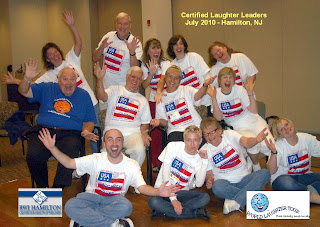"A kind word often goes unspoken, but never goes unheard."
November 2010, Columbus Ohio: My surgery for a perforated bowel was as much of a surprise as it was an emergency. There was no time to prepare but in a very important sense my preparation had already been underway because I used a particular surgery preparation method for my hip replacement a few years earlier.
I feel certain that because I had practiced the program for an earlier, planned surgery, my brain was already unconsciously "mapped" for the emergency episode.
Thanks to my nursing entourage: wife & Wonder Woman Pam, Deborah Harbinson, and Susan Stewart, this has also been true for my subsequents surgeries. There were no surprises, no emergencies, lots of preparation, and tons of support from friends and colleagues.
Both Deborah and Susan are RNs and Certified Laughter Leaders (CLLs), and Deborah is also certified in a method created by Peggy Huddleston, RN, called Prepare for Surgery, Heal Faster
If you or a loved one is facing surgery, I highly recommend that you learn and apply this method. If possible, give the patient a month or more of lead time to practice and prepare.
The audio relaxation and imagery program is excellent; it was powerful for me. Huddleston claims it will reduce anxiety before surgery, lead to using less pain medication, and help you recover faster. I used then both before and after each planned surgery, and I am convinced that it works!
My favorite imagery is the "pink, fuzzy blanket". It is so comforting to imagine being wrapped up like that. And it helped to feel the support of friends who referred to it in e-mails, text messages, and get-well card. Some even sent actual blankets!
My other favorite part of the program is writing a script for the doctors and nurses to say while I am going under the anesthesia. The unconscious mind responds to statements made within earshot of the patient. You want only positives, and lots of them, going in through the auditory channels.
Happy to report: My health care professional teams have always been cooperative and supportive.
Here is the script I used for my most recent trip to the operating room:
FOR PATIENT: STEPHEN H. WILSON, D.O.B. 1/5/1941
TO: My dear Dr. Zochowski, my anesthesiologist, and the super OR staff:
I am looking forward to the surgery you will do for me on Tuesday morning.
I am looking forward to the surgery you will do for me on Tuesday morning.
Part of my preparation is using the program created by Peggy Huddleston, RN, “Prepare for Surgery, Heal Faster.” I used this a few years ago when I had a hip replacement, and believe it was helpful. It makes use of goal-setting, visualization, progressive relaxation, and a short script for the OR staff. That’s where you come in. I earnestly request that you and the nurses and any other professionals present during the surgery take a minute or so to speak the script below.
As I am going under the anesthesia, please say:1) “Following this operation, you will feel comfortable and you will heal very well.” (Repeat 5 times.)
Towards the end of surgery, say:2) “Your operation has gone very well.” (Repeat 5 times.)
3) “Following this operation, you will be hungry for chocolate protein shakes. You will be thirsty and you will urinate easily.” (Repeat 5 times.)
4) “Following this operation, your bowels will ‘wake up’ smoothly and comfortably. At home, you will resume your program of exercises for recovery and health.” (Repeat 5 times.)
THANK YOU for what you are doing for me!.
We had copies of the script in the pre-op area, handed them out, and reviewed the instructions. Following Huddleston's advice, I also had a copy of the script pinned to gown in the middle of my chest. It was a very friendly experience that helped to put my mind at ease. I always let them know I am grateful for what they are doing for me, not what they are doing to me.
When I was wheeled into the OR and transferred to the table, the staff immediately began saying all those reassuring things to me. I remember smiling and feeling reassured. The nurse to my right, held my hand and even ad-libbed her own, sincere assurances. The anesthesia too hold gently and the surgery was a terrific success.
More On Patient Communication
Edward Leigh, a good friend and a cancer survivor, has created The Center for Healthcare Communication. (CHC). Eddie is also a Certified Laughter Leader. (If you see a pattern here of many of my friends being health care professionals as well as Certified Laughter Leaders, I believe it is a reflection of our shared humanistic orientation to our practices.)
CHC is a results-oriented organization focused on using evidence-based information to create productive healthcare organizations. They work with a variety of healthcare organizations, including hospitals, long-term care facilities, healthcare associations and medical practices.
Mission and Vision
The CHC mission is to increase patient satisfaction/safety and decrease communication-related medical errors. They accomplish this by:
- Establishing an open and empathic environment for patients and their families.
- Providing superior training, coaching and consulting services.
- Creating a productive and positive environment for people to work.
- Finding the best practices, refining them and incorporate them into other organizations.
- Providing resources to help healthcare organizations achieve excellent patient care
Their approach is comprehensive in that they work with everyone in the system (doctors, nurses, administrative professionals, etc.) to create a thriving healthcare environment.
Anyone facing surgery, and everyone who is part of a healthcare professional team, would do well to be sure they are in synch with the CHC philosophy and methods.




















